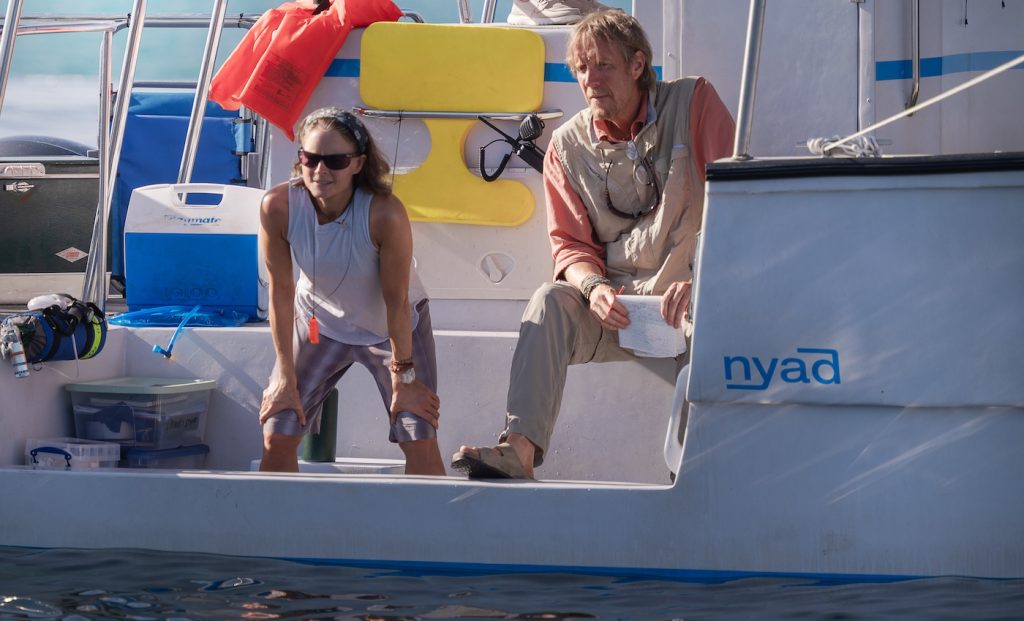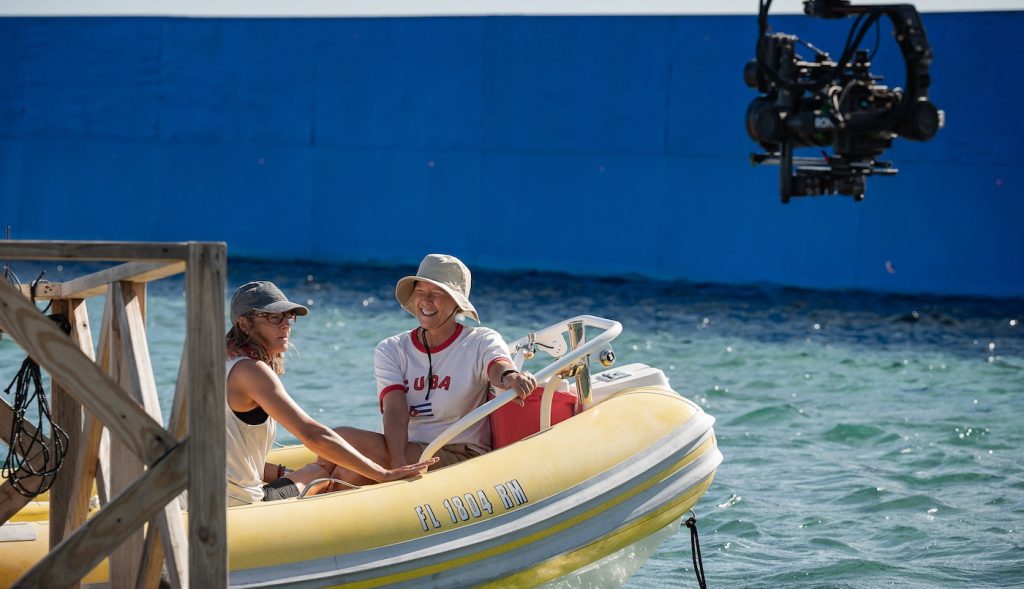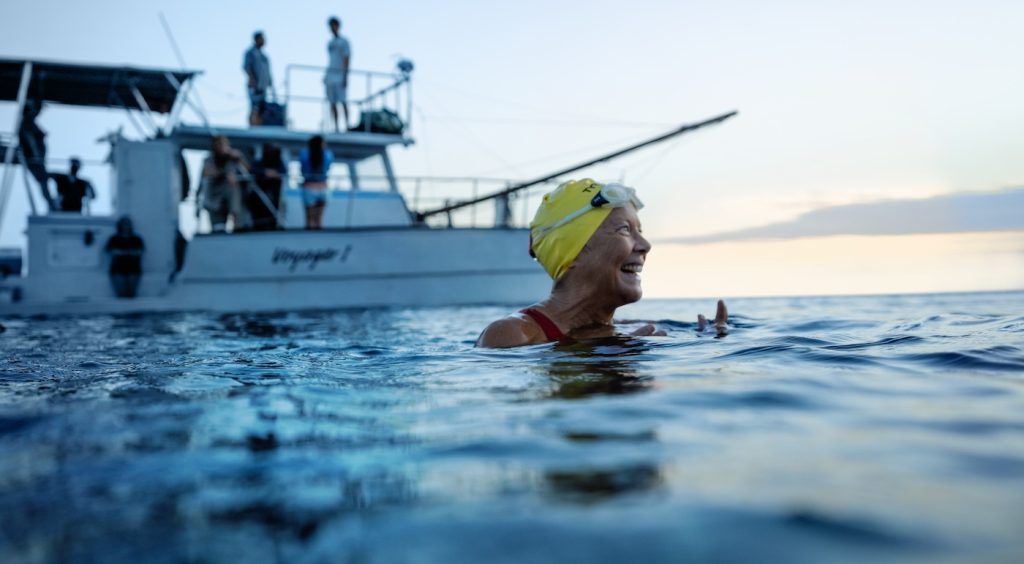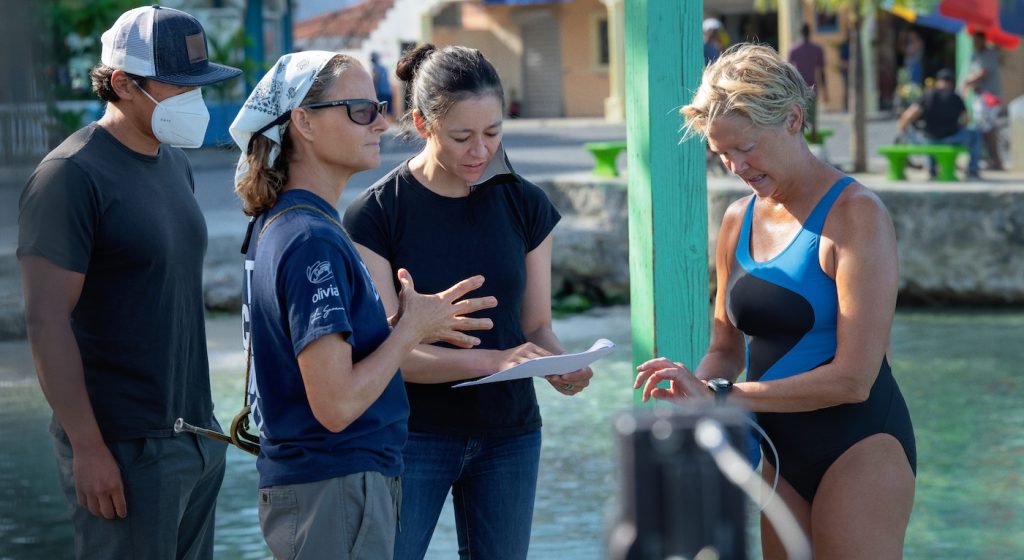“Nyad” VFX Supervisor Jake Braver on Digitally Dropping Annette Bening Into the Open Ocean
Diana Nyad would not be denied. Nyad attempted the treacherous endurance challenge of swimming from Cuba to the Florida Keys more times than a white-tip shark. The effort could have killed her—the ocean certainly tried—but ultimately, after multiple attempts, Nyad succeeded, cemented her legend, and now is the focus of Nyad, the new film from documentarians Jimmy Chin and Elizabeth Chai Vasarhelyi, the directing duo’s first narrative feature. Chin and Vasarhelyi won an Oscar for their work on Free Solo, their jaw-dropping doc about free climber Alex Honnold’s seemingly suicidal attempt to climb El Capitan in Yosemite without a rope (spoiler alert—he succeeded), so they know a thing or two about human beings who will themselves to do the impossible, possibly irresponsible, and achieve their goals.
The remarkable thing about Free Solo and Nyad is most people will know going in what the outcome is, yet the thrills remain. Diana Nyad’s decision, at the age of 60, to complete the 110-mile open ocean swim from Cuba to Florida was madness, and it’s in the specifics of each attempt and the web of personalities involved that make the movie work. From the indomitable Nyad (played by Annette Bening) to her coach and best friend Bonnie Stoll (Jodie Foster) to her salty, sui generis navigator John Bartlett (Rhys Ifans) to the box jellyfish that defend their territory and nearly kill Diana in the process, Nyad is an ensemble.
In order to drop viewers into the brutality of Diana’s attempts, however, it was going to take more than just stellar performances from committed stars (Bening trained extensively for the role)—you’re dropping Annette Bening in the dangerous, often unpredictable waters between Cuba and Florida—and that’s where VFX supervisor Jake Braver comes in. Thanks to Braver and his team, Nyad doesn’t sink but instead manages to make each attempt to cross those dangerous waters as unpredictable and downright gnarly as it was in real life. We spoke to Braver about what it took to turn a water tank in the Dominican Republic, where much of the film was shot, into the vicious Straits of Florida.
Most people will understand that Nyad was not filming in the rough waters between Cuba and Florida, so walk me through turning Pinewood’s Horizon Water Tank in the Dominican Republic into the open ocean.
The water had a job to do in the movie. It had to be something that was holding Diana back, but also something carrying her forward during the final attempt when the current was so strong. The thing that informed the methodology of the water was it needed to be a directable performance. This means we needed to shoot in the tank and needed real-life physics that are imparted on Annette and the boat and Bonnie when she’s in the water. The water needed to be able to perform, so I’d say that easily ninety percent of the water in the movie is fully CG because it needed to have a current, a look to it that matches that of the straight between Cuba and Key West, which is a very punishing current as Bartlett (Rhys Ifans) describes to Diana.

How did you do that?
We extended the tank — the tank was about 6500 square feet and had a blue screen on two sides, and one side was open for shooting. Then, the other side was this infinity edge that we ended up replacing anyway. But we were essentially extending the ocean, but also replacing the water around Diana and the boat so that it could move like water in the ocean, so it could have swells, it could drop and fall, and you could feel foam and particulate and these things you can’t do in a tank. Especially because most of the tank was pretty shallow. The center was about fifteen feet deep, but the rest of it was shallow. So it was about extending the tank not just to the expanse of the ocean, but to the depths of the floor of the ocean, too.

What’s fascinating by Nyad is that so much of the film is about her in duress in the water, and the water seems to have so many different personalities. Was every step of her journey a bespoke water environment you created?
A normal part of the visual effects process when you’re dealing with CG-heavy shots is called layout, which is basically taking the camera and taking the objects in the frame and figuring out their relationships to each other. We developed a kind of bespoke layout process for this movie, where we built a couple of different ocean sets that had matching characteristics and a variety of speeds and amplitudes. Then, we used a custom process to simulate those across several hundred shots so that for each shot, we had three or four options for the amplitude and speed of the ocean. So I sat down with Chai and Jimmy, and we went through every water shot in the movie and asked, okay, what should the water be doing here? We were able to really dial in, per shot, what we wanted the water to be doing on a per shot basis. The water needed to be character.

Yet, as much as this film would sink or swim based on how believable the ocean was, it’s really about Diana and her incredible will to accomplish this feat, even at the expense of her relationships and her own health.
Yes, we also had choices that were a lot more story-driven. So this process we created did two things: it allowed myself, Jimmy, and Chai to be able to have a clear blueprint of what were going for, and it also enabled a conversation between all of us and the editor, Christopher Tellefsen, about what the water needed to be doing at that particular moment. I don’t know if this is a movie that could have been made five years ago. Water is still very hard. Our visual effects vendors that handled the water, DNEG, Weta FX, and Scanline VFX, have a lot of water veterans. They all said this was the toughest water movie they’d been a part of because of what we were asking water to do. Here, we had someone performing in the water the whole time, and the water had to work with Annette, or the movie wouldn’t work at all. Simulation technology has progressed to the point where you can iterate faster than ten or fifteen years ago, but our work had this X factor that we had this person that the water had to make sense with.
What was it like working with Chai and Jimmy on their first narrative feature?
The magic of Chai and Jimmy is they have this incredible ability as filmmakers, be it narrative or nonfiction in their doc work, to tell you a story where you know the outcome, but you’re still on the edge of your seat. They’re masters at that. The way we did that in this movie is by differentiating Diana’s attempts. We have different encounters, from the box jellyfish to the storm to the sharks, finding new ways to inject something you haven’t seen before.

I still can’t believe she didn’t use a shark cage. Speaking of sharks…I’m going to assume that wasn’t Annette Bening in the water with an actual shark.
You are correct that we did not put Annette in the water with real sharks, although she probably would have been game. Weta FX did the sharks, and we started by looking at a lot of real references of oceanic white-tip sharks and their behavior. One of the things I spoke about really early with Chris White, Weta FX’s supervisor, was that the sharks were really about the scariness of the open ocean. Emotion was our goal. Lots of movies have done bigger and badder shark sequences, but for us, it was about keeping you with Diana and her fear. We really wanted to keep the shark sequence grounded in the story rather than all of a sudden have a ten-minute break for a shark movie. You don’t have great visibility in the open ocean; you can’t see that far. We don’t cut to a close-up of the shark right away because what we want people to experience is, ‘Oh wait, is that a shark? Oh, that is a shark.’
From the terrifying to the sublime, how did you construct the moment when Diana hallucinates that she’s swimming towards the Taj Mahal?
That was a really fun challenge because it is this break from reality, and this hallucination gives you a sense of just how out there Diana was at that moment. It was about finding the right scale for the Taj Mahal. We wanted it to feel grand and imposing, but it had to fit in the frame with Diana. We did a lot of concept art and a lot of animation tests to figure out how to get a playful performance out of the tropical fish guiding her there. We gave the Taj Mahal this mixed color temperature with these shafts of light coming through, and I think Annette makes you believe Diana thought it was real.
For more on big titles on Netflix, check these out:
Final “Leave the World Behind” Trailer Teases Netflix’s Tense Star-Studded Thriller
“May December” Director Todd Haynes on Playing With Power in His Beguiling New Film
First “Society of the Snow” Trailer Reveals J.A. Bayona’s Decade-in-the-Making Survival Epic
Featured image: NYAD. Annette Bening as Diana Nyad in NYAD. Cr.Liz Parkinson/Netflix ©2023



